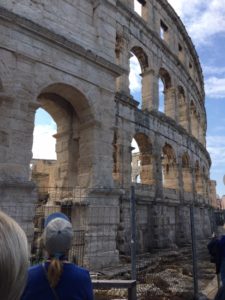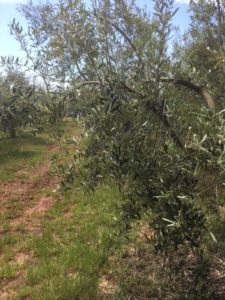Yesterday we awoke in the coastal town of Opatija, Croatia, covered by pillows of fog. We were unable to see the Adriatic Sea, even though the waves began a hundred feet from our balcony. Stumbling through the fog to the bus, we drove forty miles to the town of Pula. There, a marvelous structure awaited us: a largely intact Roman amphitheater, one older than Diocletian’s Palace. Everyone in the group was excited about visiting this rarity, but expressed worry about the weather. Would we ever see the blue skies?
 After three miles of tunnels to the other side of the mountains, we emerged into what seemed a different climate: dry, fragrant air, rolling hills, and sunshine! An hour later, we were pulling into Pula, where the arches of the amphitheater towered over us. It was as if Zeus had dropped the whole thing from the sky.
After three miles of tunnels to the other side of the mountains, we emerged into what seemed a different climate: dry, fragrant air, rolling hills, and sunshine! An hour later, we were pulling into Pula, where the arches of the amphitheater towered over us. It was as if Zeus had dropped the whole thing from the sky.
For two hours we explored this magnificent structure, ending with a visit to the subterranean chambers where the gladiators and animals awaited either victory or death. The bodies of the losers also were stored there until they could be dragged out to sea.
Then it was time to board the bus and drive further across the Istrian peninsula to the stunning seaside town of Rovinj. But first, we were scheduled to have an authentic Istrian olive-oil tasting.
Far too often, in my experience at least, tastings of regional specialties like cheeses, chocolates, or wines become thinly disguised marketing moments. But this one, gratefully, was not. Instead, we received an authentic education in olive oil, and a charming one at that!
Following a path alongside an olive grove, we emerged into a cluster of neat houses belonging to one extended family. There a young woman named Ivana awaited us, ready to introduce us to her olive trees. Istria has long been a prime region for the production of olives. Lately, Istrian groves have been bumping places like Tuscany down in ranking! As it turns out, Ivana’s groves have been part of this movement, sweeping many of the world’s top olive-oil prizes.
In the course of her remarks, I learned what many of you already know about olive oil, beginning with the fact that much of what appears on labels of store-bought olive oils is misleading. Promoting an olive oil as special because it is produced from green or black olives tells little, since all olives begin green and darken to black. Phrases such as “extra-extra” virgin oil, also are meaningless in terms of quality.
 But the shocker, for me, was hearing that producers can fill a good portion of the bottle with vegetable oil, fill the rest with olive oil, and still call the product “olive oil.” This admixture has an attractive price, of course, but the oil will have no therapeutic qualities and very little taste.
But the shocker, for me, was hearing that producers can fill a good portion of the bottle with vegetable oil, fill the rest with olive oil, and still call the product “olive oil.” This admixture has an attractive price, of course, but the oil will have no therapeutic qualities and very little taste.
We also learned about the four-hour window in which olives, once shaken from the branches, must be gathered and stored quickly in special vats filled with argon gas so that oxidation will not set in. Ivana said the family’s groves were harvested during a frantic two-week period in late fall.
She then described how their groves began. An initial group of 100 trees were planted 22 years ago when two then-teenage brothers wanted to pay tribute to their father and grandfather, both of whom had died within months of each other. That original grove grew to 15,000 trees, 7,500 of which produce olives using certifiably organic methods.
That was another interesting part of the story. During the Tito period (post-World War II through 1980), Yugoslavia became highly industrialized. People in rural areas like Istria were more-or-less forced into factory work. The traditional groves languished to the point of neglect, so that the whole olive industry had to be revived after the fall of Communism.
 But those years of neglect (particularly the 1960s and 70s) corresponded with the years when pesticides like DDT were introduced enthusiastically into agriculture. Because Istria’s groves were mostly inactive, such pesticides were never applied there. The soil remained free of their damaging effects. Thus, with the return of olive production in the 1990s, organic farming was easier to inaugurate for both olives and grapes.
But those years of neglect (particularly the 1960s and 70s) corresponded with the years when pesticides like DDT were introduced enthusiastically into agriculture. Because Istria’s groves were mostly inactive, such pesticides were never applied there. The soil remained free of their damaging effects. Thus, with the return of olive production in the 1990s, organic farming was easier to inaugurate for both olives and grapes.
Then we entered an attractive “tasting” room with tables loaded with local cheeses, intense wild-boar sausage, fresh bread, and wine from the next-door neighbor’s vineyard. In the middle of each plate stood a round crystal glass—something like a brandy snifter without the pedestal. Inside was a puddle of olive oil. We were asked to sniff the oil. Then she told us to put one palm under the glass, one palm over the opening, and hold our hands there to warm the oil while her talk continued. About ten minutes later, she said, “Now smell the oil.”
Oh my goodness. The aroma had sharpened and expanded. We smelled everything she described: freshly cut grass; pressed leaves; fruit, herbs, and even a whiff of damp soil. Then she taught us how to “taste” olive oil, forming something like a reverse whistle: shut your teeth, put your tongue behind the teeth, and inhale vigorously. This way, the olive oil goes into your cheeks. “The sides of your mouth will have a bitter taste, while the oil going down your throat will taste spicy,” she said. Right again, Ivana, although don’t ask me how.
We were now experts. The rest of the visit was spent dipping different foods in the oil while Ivana taught us more facts. My group was clearly embracing the experience and she was pleased. Of course, many of the guests bought olive oil from her darling shop. But her pleasure, I think, also had to do with the clear sense that she was reuniting with the Istrian ancestors who, up until the Second World War, had tenderly cultivated this land.
We left the olive grove reluctantly and headed to the coast. Thirty minutes later, the last hill fell away and we were perched again above the Adriatic, sans fog. A sparkling mirror of blue stretched before us. After several hours in the Venetian-style Renaissance town of Rovinj, we returned back in Opatija for a seafood dinner that surpassed our highest expectations.
Soon we’ll be headed south down the Dalmatian coast, passing areas where the horrific Homeland War of the early 1990s destroyed ancient towns, churches, and monasteries. We’ll end up right next to the 15th-century walls of Dubrovnik—walls that held fast against the modern artillery that bombarded them for weeks during that war. And, of course, that awful war was just one of a long series of conflicts that have tousled the entire Balkan peninsula since history has been recorded.
How could there be so much beauty, on one hand, and horror, all within one ravishing patch of land? That is the question my guests soon will be asking, as we leave tomorrow and head into the contested territory that is still rebuilding from the latest destruction.



